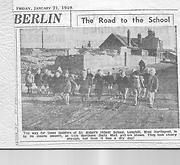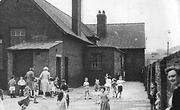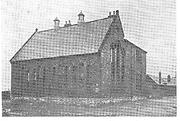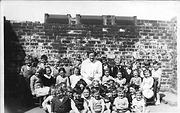 Hartlepool Sports & Leisure
Hartlepool Sports & Leisure
- Cinemas, Theatres & Dance Halls
- Musicians & Bands
- At the Seaside
- Parks & Gardens
- Caravans & Camping
- Sport
 Hartlepool Transport
Hartlepool Transport
- Airfields & Aircraft
- Railways
- Buses & Commercial Vehicles
- Cars & Motorbikes
- The Ferry
- Horse drawn vehicles
 A Potted History Of Hartlepool
A Potted History Of Hartlepool
- Unidentified images
- Sources of information
- Archaeology & Ancient History
- Local Government
- Printed Notices & Papers
- Aerial Photographs
- Events, Visitors & VIPs
 Hartlepool Trade & Industry
Hartlepool Trade & Industry
- Trade Fairs
- Local businesses
- Iron & Steel
- Shops & Shopping
- Fishing industry
- Farming & Rural Landscape
- Pubs, Clubs & Hotels
 Hartlepool Health & Education
Hartlepool Health & Education
- Schools & Colleges
- Hospitals & Workhouses
- Public Health & Utilities
- Ambulance Service
- Police Services
- Fire Services
 Hartlepool People
Hartlepool People
 Hartlepool Places
Hartlepool Places
 Hartlepool at War
Hartlepool at War
 Hartlepool Ships & Shipping
Hartlepool Ships & Shipping

St Aidan's Longhill School
Details about St Aidan's Longhill School
This school opened in August 1874 for the children of Longhill or Wagga estate built by Thomas Richardson.
In 1887, there were 340 children on role and in by 1906 there were 548. In 1899, a new extension was built for infant children. This was opened in 1902 and the mayor and mayoress were unable to reach the school because of the poor road to it.
Eventually the school was an infants' school only as part of St Aidan's School and the young children finally were relocated to the 'big school' in Loyalty Road in 1960. The school building which was surrounded by steel works buildings was for many years afterwards used a garage for a haulage company. The school was affectionately known as 'Wagga College' or 'The Little School'.
Location
Related items :
 Infant children at Longhill
Infant children at Longhill
 Created by northern daily mail
Donated by St Aidan's Primary School
Created by northern daily mail
Donated by St Aidan's Primary SchoolDated 1949
Taken by Hartlepool Mail, the image is poor but very interesting as it shows how poor the road to the school was. On the left is a pile of rubble indicating that the 1874 building had fairly recently been demolished.
More detail » Longhill 1959
Longhill 1959
 Donated by Frances Wilson
Donated by Frances WilsonDated 1959
Taken around 1959, the picture shows the playground of St Aidan's Infant School Longhill. On the right wearing glasses is the headmistress Miss Molly Pattison who later went on to Oxford Street School.The other two adults are Reta Campbell and Jean Bluckert. Behind the wall on the right was Windermere Road and behind the school were the Steelworks cooling towers. Just out of sight is Seaton High Light which has now been moved to the Marina.
The infants' school moved to St Aidan's Loyalty Road in 1960-1.
More detail » Longhill Infant 1 1949
Longhill Infant 1 1949
 Donated by St Aidan's Primary School
Donated by St Aidan's Primary SchoolDated 1949
35 children dressed in their best in 1949. These woud be the oldest children which we would now call Year 2.
More detail » Longhill Infants School
Longhill Infants School
 Donated by St Aidan's Primary School
Donated by St Aidan's Primary SchoolDated 1932
The infants' part of Longhill School in Windermere Road taken in 1932.
More detail » Longhill School
Longhill School
My mother taught at St Aidan's Infants School Longhill and was called Mrs Johnson. As a young child I visited the school many times and it sticks in my memory more vividly than Lister Street Infants' which I attended myself. The reasons must be because even to my 7or 8 year old brain, I must have realised that I was stepping back in history and that this school was nothing like the one I attended.
Firstly, the journey to get there. Before we had a car, we walked what seemed like miles until the streets became orange with what I now realise was iron dust and mud. The school was a small building shadowed by a huge steel works cooling tower and there were clanking noises all around. On a small piece of scrubland next to the school were a scattering of gypsy caravans and horses.
Until the school closed in 1960,there were huge open fires for heat and the lighting was still by gas. I do remember being frightened of the toilets at the bottom of the yard which were holes in planks of wood and if I remember rightly they had no flush but periodically were ' flushed ' by a mystery flow of water. I do remember that the school quite often had a break in and helping to tidy up piles of chalk, books and drinking straws! The schoolroom at Beamish reminds me of what I remember of Longhill 'little school' .
More detail » Longhill School
Longhill School
 Donated by St Aidan's Primary School
Donated by St Aidan's Primary SchoolVery poor but rare image of the 1874 Longhill School in Windermere Road with the infant department of 1902 to the right. Junior and senior pupils were moved to the new Memorial School in 1926. However, by 1927 there were 216 children attending the small infants' department and two rooms in the old building had to be used.
By 1938, St Aidan's Parish magazine mentioned that the state of the old school building was causing concern. When exactly it was demolished is unclear but on the 1949 Hartlepool Mail photo of infant children outside the school, the large pile of rubble seems to be the remains of the 1874 building.
More detail » Longhill School History
Longhill School History
In 1998, the 'All our Yesterdays' Writers' Group published a book Reflections Beneath the Wagga Moon and the following are from that book which is in Hartlepool Library.
Thomas Richardson, a Liberal rival of Ralph Ward Jackson, wanted votes at the 1874 elections and this is one of the reasons he purchased the blast furnaces and rolling mills to the south of Stranton. He then built homes for his workers in the area of Seaton parish known as Longhill. Because the area was undrained, unpaved, unlit and was also a site for travelling families, it became known as Wagga. The more affluent workers settled in the South Parade and Studley Road areas of nearby Belle Vue.
The three main streets built at the time by Richardson were Florence Street, Hill Street and Portland Street. Slightly to the north west of these streets and separated by bogs and random allotments were Sarah Street, Alice Street and King Street.
A school,known as 'Wagga College' by the residents of the area, was built, but it was some years later in the early 1900s ,that it was linked by a cinder track to Windermere Road and on to Brenda Road.
The school was built in 1874 when Richardson gave some land to the Archdeacon of Durham and the Vicars of Seaton and Greatham on which to build a school and he himself donated £200 of the £900 it cost to build.
In 1913, WR Owen in his book about education in Hartlepool observed 'The district was known as Wagga Wagga on account of its wild aspect. The approaches were bogs and altogether it was not the most desirable of residence.' In 1875, there were four headteachers in a year which has been attributed to the unpleasant surroundings of the school.
In 1890, because of the formation of St Aidan's Parish, the school was no longer in Seaton Carew parish and was renamed St Aidan's Church of England School Longhill. R.E. Knowlden who was priest from 1897, showed concern for the school. The area around it was little better than when it was built although some pathways had been laid. In 1899 an Infants' School was begun and in 1902, opened. Prior to this, children of all ages had been in the 1874 building.
Inspectors in 1909 said 'The school is overcrowded, one room contains 84 children. There are only 3 closets for 200 boys. The walls are very dirty. Guards should be provided for the open fireplaces.
Rev Knowlden continued to show concern for the state of the school, and when some 102 past pupils did not return from WW1, he decided that a fitting memorial to them would be a new school. He spent much of the next 10 years fundraising and on the 21st May 1926 the school was ready for pupils.
In May 1926, 336 scholars were marched from Longhill to the new Memorial School in Loyalty Road leaving just the youngest children at Longhill. Rev Knowlden and staff and children continued to fund raise although he himself passed away in November 1929.
Susan Moore was for many years a teacher, having been employed initially by Rev Knowlden. She then became headteacher at Longhill Infants and later at Loyalty Road when the children finally moved there in 1960 and these are some of her words:
'I became headteacher of St Aidan's Infants' School in 1947 and I look back with great pleasure at those years spent in the old building which lacked all the modern facilities of schools today. It came as a shock to me to discover that the old fashiioned lavatories where one tank flushed the channel of a whole row of toilets, were still in use.
The staff spared no effort in making the school attractive and teaching effective. and when showing of films became fashionable, Miss Molly Pattison made a projector which had to be run from a car battery as we had no electricity, only gas in school.
Despite the proximity of the heavy industrial works, the health and consequently attendance of the children was very good.. We were always the last to suffer from epidemics of measles, chicken pox and mumps.
During my retirement, I meet many old pupils and they all look back, as indeed staff do, with pleasure and gratitude to the days when they lived and learned in a controlled but happy atmosphere.' (Miss Moore lived to be over 100 having been born in 1906)
By 1940, the original streets of Wagga, Florence, Hill and Portland were empty and were used by the Auxiliary Fire Service for war time survival practice. Infant age children attending the school came from the Belle Vue area. After World War 2, quite a significant number of 'prefab' bungalows and houses were built close to the school in Coniston Road, Langdale Grove, Shap Grove and Bowness Grove. These houses too are long gone and, like Longhill School, would have been to the east of Belle Vue Way in an area of recycling plants and scrap yards today.
In 1960, the school closed and children were tranferred to the Memorial School in Loyalty Road on December 10th of that year.
In 1964, the old Longhill School was sold to scrap merchant J Shaw for £1,119 15s 9d for use a store room. Now, Longhill has gone completely and there is no evidence at all of where either houses in 'Wagga' or the school stood.
More detail » Longhill School staff 1958-9
Longhill School staff 1958-9
 Donated by Frances Wilson
Donated by Frances WilsonDated 1958
Longhill School staff I believe just prior to move to St Aidan's.
More detail » Longhill Staff 1956
Longhill Staff 1956
 Donated by St Aidan's Primary School
Donated by St Aidan's Primary SchoolDated 1956
Taken in the infants' school yard are headteacher Susie Moore, Joan Baxter, ?, and Joyce Parkin.
More detail » Longhill class 1956
Longhill class 1956
 Donated by St Aidan's Primary School
Donated by St Aidan's Primary SchoolDated 1956
The teacher is Mrs Reta Campbell who, when the infants moved to Loyalty Road, became deputy headteacher.
More detail » Longhill staff 1949
Longhill staff 1949
 Donated by St Aidan's Primary School
Donated by St Aidan's Primary SchoolDated 1949
On this photo are 2nd left Joyce Parkin then headteacher Susie Moore, unknown and on the right Molly Pattison who later was headteacher of Longhill and then Oxford Street.
More detail » Longhill staff 1952
Longhill staff 1952
 Donated by St Aidan's Primary School
Donated by St Aidan's Primary SchoolDated 1952
On this 1952 photo, the lady sitting in the middle is headteacher Susan Moore.The lady standing on the right is Joyce Parkin (known by children as Miss Joyce)The Lady standing on the left of the headteacher Susan Moore is Doreen Rouse (Doreen Harlow).
More detail » St Aidan's Boys School - Standard 1, 1949
St Aidan's Boys School - Standard 1, 1949
 Donated by Mr. Jimmy Buglass
Donated by Mr. Jimmy BuglassDated 1949
St Aidan's Boys School, Standard 1, 1949.
Jimmy Buglass is seated on the front row, third from the right. Do you recognise anyone elso in the photograph?
More detail » St Aidan's Infants, Longhill 1952
St Aidan's Infants, Longhill 1952
 Donated by Christine Fox
Donated by Christine FoxDated 1952
St Aidan's Infants, Longhill 1952.
Known faces are : 7th from left back row Alfie Walsh.
Middle: ?, ?,Harold Hatley, Veronica Bennett, Paula Nash, Linda Braham, Ivor THomas, ?, Carole O Connor, ?, ? , Tommy Rudd, ?
Front row: 4th from left Marlene Hall,?,Margaret Pike, Irene Chilton, ? ,?, Miss Dobson, ?, Carole Thompson, Pauline Ainsley, ? , Valerie STott , Jaqueline Playfor
The teacher is Miss Doreen Rouse, who later married Seaton Golf Professional Roy Harlow.
More detail » St Aidan's Longhill School
St Aidan's Longhill School
This school opened in August 1874 for the children of Longhill or Wagga estate built by Thomas Richardson.
In 1887, there were 340 children on role and in by 1906 there were 548. In 1899, a new extension was built for infant children. This was opened in 1902 and the mayor and mayoress were unable to reach the school because of the poor road to it.
Eventually the school was an infants' school only as part of St Aidan's School and the young children finally were relocated to the 'big school' in Loyalty Road in 1960. The school building which was surrounded by steel works buildings was for many years afterwards used a garage for a haulage company. The school was affectionately known as 'Wagga College' or 'The Little School'.
More detail »





